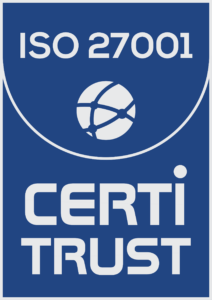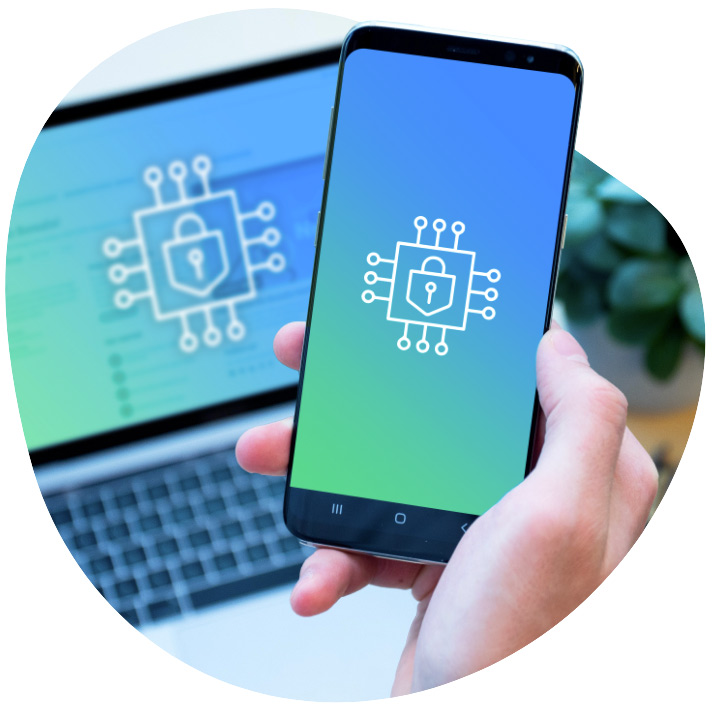Seguridad

Certificación ISO 27001
¿Qué es la certificación ISO 27001?
ISO 27001 es una norma reconocida internacionalmente que ayuda a las organizaciones a gestionar la seguridad de la información para que sus activos de información sean más seguros.
Para obtener la certificación, una organización debe desarrollar y aplicar un estricto programa de seguridad, evaluar periódicamente los riesgos, amenazas y vulnerabilidades de la seguridad de la información, y establecer que sus programas de seguridad se ajustan a las mejores prácticas del sector.
Tras superar con éxito una auditoría realizada por un tercero independiente, la organización puede ser certificada por un registrador acreditado.
organization must develop and implement a strict security program, regularly evaluate information security risks, threats, and vulnerabilities, and establish that its security programs align with industry-leading best practices.
After a successful audit is performed by an independent third party, the organization can be certified by an accredited registrar.
– Patrick Grégoire, Presidente, Borealis
¿Qué es la certificación ISO 27001?
ISO 27001 es una norma reconocida internacionalmente que ayuda a las organizaciones a gestionar la seguridad de la información para que sus activos de información sean más seguros.
Para obtener la certificación, una organización debe desarrollar y aplicar un estricto programa de seguridad, evaluar periódicamente los riesgos, amenazas y vulnerabilidades de la seguridad de la información, y establecer que sus programas de seguridad se ajustan a las mejores prácticas del sector.
Tras superar con éxito una auditoría realizada por un tercero independiente, la organización puede ser certificada por un registrador acreditado.
Security has always been and always will be at the core of our product. The fact that more and more Fortune 500 companies are choosing our solution is proof of our product’s quality and security.
– Patrick Grégoire, Presidente, Borealis
Tecnología IA (Inteligencia Artificial)
Para ayudar a los usuarios a obtener el máximo de rentabilidad de su inversión, Borealis integra herramientas y funciones de IA para mejorar el relacionamiento con los grupos de interés sin comprometer la información sensible.
¿Compromete la privacidad de los datos el uso de información obtenida con IA?
Cualquier información generada por este análisis de IA se utiliza éticamente, con el único propósito de ayudar a los usuarios a comprender y gestionar mejor el relacionamiento con los grupos de interés; nunca se utilizará para marketing o publicidad ni se compartirá con terceros para ningún otro fin. Su privacidad y sus preferencias son importantes para nosotros. Si decide no utilizar la función de IA integrada o desea desactivarla, nuestro equipo de soporte le ayudará en este proceso. Siempre tendrá pleno control sobre sus datos dentro del sistema, y mecanismos transparentes para gestionar su información.

Seguridad del centro de datos
Los servidores de producción Boréalis están alojados en Canadá, Francia y Australia en un centro de datos TIER III (Clasificación del Uptime Institute). El sistema posee la certificación ISO 27001: 2005, así como el cumplimiento de las auditorías SOC 1 Tipo II (SSAE 16 e ISAE 3402) y SOC 2 Tipo II. El centro de datos está equipado con una sólida seguridad física que incluye biometría, acceso con tarjeta inteligente y seguridad lógica incluyendo cortafuegos (firewall), detección de intrusos, videovigilancia, así como la prevención y la protección contra ataques de denegación del servicio. La alimentación, el sistema de enfriamiento y las redes son totalmente redundantes y han sido construídos para un mínimo de redundancia N+1.

Funcionalidades de seguridad del producto

Aplicación de niveles de seguridad

Copia de seguridad (Backup)

WCAG

Seguridad de la red

Monitoreo y Gestión de Vulnerabilidad
Borealis trabaja con especialistas de seguridad externos y emplea soluciones de seguridad de clase empresarial para detectar y corregir las vulnerabilidades en la infraestructura de TI y en la aplicación web.
Borealis utiliza sistemas de gestión de vulnerabilidades para proteger continuamente la infraestructura TI contra las últimas amenazas de Internet. A través de una aplicación web de rastreo monitoreamos nuestra solución TI para identificar los 10 más altos riesgos de la OWASP incluyendo la inyección SQL, el filtro de scripts de sitios (XSS), la falsificación de petición en sitios cruzados (CSRF pour sus siglas en inglés) y la redirección URL.
Todas las aplicaciones web, redes y hardware son supervisados constantemente tanto por Borealis como por los proveedores de coubicación gestionada.

Acceso a la administración del sistema y Soporte global

Seguridad de almacenamiento
Todos los datos almacenados en los servidores de Borealis se cifran en reposo mediante un protocolo SSL de alta calidad que utiliza AES-XTS, un protocolo acriptográfico diseñado para garantizar la seguridad del almacenamiento de datos en reposo. Las claves de cifrado se almacenan de forma segura.

Transmisión y Seguridad de la sesión



